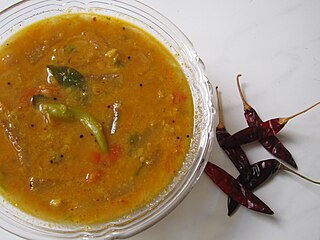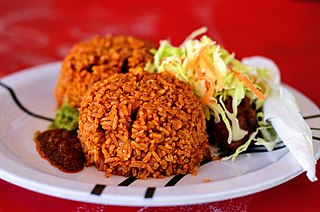Related Research Articles

Fried rice is a dish of cooked rice that has been stir-fried in a wok or a frying pan and is usually mixed with other ingredients such as eggs, vegetables, seafood, or meat. It is often eaten by itself or as an accompaniment to another dish. Fried rice is a popular component of East Asian, Southeast Asian and certain South Asian cuisines, as well as a staple national dish of Indonesia. As a homemade dish, fried rice is typically made with ingredients left over from other dishes, leading to countless variations. Fried rice first developed during the Sui Dynasty in China.

Sambar, known as Kuzhambu in TamilNadu, is a lentil-based vegetable stew, cooked with pigeon pea and tamarind broth. It is popular in South Indian, Sri Lankan and Maldivian cuisines. The stew has been adapted into Burmese cuisine as a popular accompaniment to Burmese curries.

Mexican rice, also known as arroz a la mexicana, arroz mexicano, sopa de arroz, or arroz rojo in Spanish, is a Mexican side dish made from white rice, tomato, garlic, onion, and perhaps other ingredients. Mexican rice is almost always eaten as a complement to other dishes such as mole, refried beans, rotisserie chicken, carne asada, picadillo, tacos, fried fish, fried chicken, chiles rellenos, or vegetable soup.

Jollof, or jollofrice, is a rice dish from West Africa. The dish is typically made with long-grain rice, tomatoes, chilies, onions, spices, and sometimes other vegetables and/or meat in a single pot, although its ingredients and preparation methods vary across different regions. The dish's origins are traced to the Senegambian region.

Ghanaian cuisines refer to the meals of the Ghanaian people. The main dishes of Ghana are organized around starchy staple foods, accompanied by either sauce or soup as well as a source of protein. The main ingredients for the vast majority of soups and stews are tomatoes, hot peppers, and onions. Most Ghanaian soups and stews are red or orange in appearance as a result of the main ingredients used.

Draw soup is the name of soups from the southeastern and southwestern parts of Nigeria that are made from okra, ogbono(Irvingia gabonensis), or ewedu leaves (jute). The name derives from the thick viscosity characteristic of the broth as it draws out of the bowl when eaten either with a spoon or, more characteristically, by dipping a small piece of solid (fufu) into it. It can be served with numerous Nigerian fufu meals, including eba (garri) and pounded yam. Ewedu can be used to make a Yoruba soup that is traditionally served with amala.
Sierra Leonean cuisine consists of the cooking traditions and practices from Sierra Leone. It follows the traditions of other West African cuisines. The country has 16 tribal ethnic groups.

West African cuisine encompasses a diverse range of foods that are split between its 16 countries. In West Africa, many families grow and raise their own food, and within each there is a division of labor. Indigenous foods consist of a number of plant species and animals, and are important to those whose lifestyle depends on farming and hunting.

Nigerian cuisine consists of dishes or food items from the hundreds of Native African ethnic groups that comprise Nigeria. Like other West African cuisines, it uses spices and herbs with palm or groundnut oil to create deeply flavored sauces and soups.

Tiep or thieb is a traditional dish from Senegambia that is also consumed in Guinea Bissau, Guinea, Mali and Mauritania. It is the national dish in Senegal. The version of tiep called thieboudienne or chebu jen is prepared with fish, broken rice and tomato sauce cooked in one pot. There are also tiep yappa and tiep ganaar. Additional ingredients often include onions, carrots, cabbage, cassava, hot pepper, lime and peanut oil, and stock cubes.

Liberian cuisine refers to the cuisine of Liberia. It is centered on the consumption of rice, cassava, plantain, yam, tropical fruits and vegetables, as well as fish, meat, and more.

Roselle juice, known as bissap, wonjo, foléré, dabileni, tsobo, zobo, siiloo, soborodo or Sobolo in parts of Africa, sorrel in the Caribbean, and agua de Jamaica in Mexico, is a drink made out of the flowers of the roselle plant, a species of Hibiscus. Although generally the "juice" is sweetened and chilled, it is technically an infusion and when served hot can also be referred to as hibiscus tea.

Ofada rice is a Yoruba dish. It is the name of an indigenous rice from a small community called Ofada, located in the Obafemi Owode Local Government Area of Ogun State. It is not exclusively grown in the community, but it is an indigenous rice grown in southwest Nigeria but named after the Ofada community. It is used in making a variety of dishes. Ofada rice are mostly blends, and some of the rice varieties in the blends are not indigenous to Africa; however, they usually also contain African rice. It is grown almost exclusively in Ogun State, a state in southwestern Nigeria. Ofada rice is grown on free-draining soil where the water table is permanently below the root of the plant.

Atama soup or Amme-Eddi is also called Banga Soup in pidgin English(Nigerian English) It is a kind of palm-fruit vegetable soup that originates from the Efik people of Cross River state and Urhobo people of Delta State in South South Nigeria. It’s a popularly food among the Delta, Cross River and Akwa Ibom State People of Nigeria. The Urhobo people of Delta state called it Amme-edi or Banga soup. The soup is made from palm fruit-pulp that is derived from palm fruit; the extracted palm-pulp is base primary ingredient for the soup. Atama or Amme-edi(Banga) soup is thick and dark brown in color. It’s normally prepared with choice of protein like fresh meat or dry meat(mostly bush meat), dry fish, fresh fish and sometimes shrimp(dry or fresh), periwinkle as added proteins for more enhanced flavor. Ingredients: primary ingredients are fresh palm-pulp sourced from palm fruit, salt and pepper and secondary ingredients which are decided based on preference of the cooker are onions, salt, pepper(different kinds of pepper are preferences) and different kinds of spices could be added depending on the cooker preferred or desired taste or flavor. This soup could be styled into different flavors depending on cooking preferences. Every added ingredient could drastically change the taste of the food.

Ofe Oha is a soup mostly eaten in the south eastern part of Nigeria.
Miyar Zogale is an Hausa dish also known as morning soup. It is made with moringa leaf as the main ingredient, others include groundnut paste, grounded tomato, beef, cubes, daddawa and palm oil.
Ofe Owerri is an Igbo delicacy in the South-Eastern part of Nigeria. The soup is made with snails, beef,assorted meat and fishes.
Fio Fio is a Nigerian food peculiar to the South-Eastern part, the soup is made guinea pea and cocoyam as the major ingredients.
Kekefia is a side-dish of the Southern part of Nigeria, the meal is popular among the people in Bayelsa state.

Snail pepper soup is a local side-dish of the South-eastern region of Nigeria. It is prepared with Africa giant snail is the main ingredient. The soup is popular in the Niger Delta and with people from the upper region of Cross River State.
References
- ↑ "Traditional Way To Prepare Rice". The Guardian Nigeria News - Nigeria and World News. 2018-08-16. Retrieved 2022-07-01.
- ↑ Onyeakagbu, Adaobi (2021-12-09). "Everybody should know how to make this concoction rice". Pulse Nigeria. Retrieved 2022-07-01.
- ↑ "How To Make Native Jollof Rice". The Guardian Nigeria News - Nigeria and World News. 2020-06-28. Retrieved 2022-07-01.
- ↑ "Concoction rice". ResearchGate.